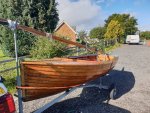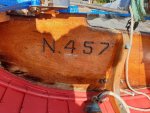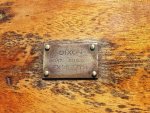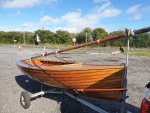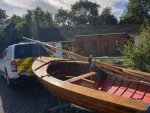You are using an out of date browser. It may not display this or other websites correctly.
You should upgrade or use an alternative browser.
You should upgrade or use an alternative browser.
Can anyone tell me what this is please?
- Thread starter Stu j
- Start date
jamie N
Well-known member
Welcome!
That's a very old National 12. No.457 I'd say.
That's a very old National 12. No.457 I'd say.
Stu j
New member
Built in 1939 name is sunbeam.
I've since found out that there is a national association?
I've since found out that there is a national association?
Stu j
New member
National 12 association
jamie N
Well-known member
Yours looks fully restored, or rather as if it's been properly cared for throughout its life.
Sticky Fingers
Well-known member
As said this is a National 12. A very long established development dinghy class, active Class association and fleets all over the country. I'm an ex-N12 owner (1980s) , lovely boat but it's not one for an old bloke like me (now)... You need to be agile and small.
Hope you plan to care for and sail her.
Gratuitous pics of mine, now sold. Tigress, N3127. What a lovely thing.


Hope you plan to care for and sail her.
Gratuitous pics of mine, now sold. Tigress, N3127. What a lovely thing.


Stu j
New member
She has been fully restored by her previous owner. However as you say they are a busy little craft and Richard ,(previous owner) is now 80 so decided to let her go.As said this is a National 12. A very long established development dinghy class, active Class association and fleets all over the country. I'm an ex-N12 owner (1980s) , lovely boat but it's not one for an old bloke like me (now)... You need to be agile and small.
Hope you plan to care for and sail her.
Gratuitous pics of mine, now sold. Tigress, N3127. What a lovely thing.
View attachment 123578
View attachment 123579
Unfortunately the people who took her hadn't fixed hr to the trail correctly and caused some damage to the Hull.
Any ideas where I cold buy the ship lap boards for the Hull
Not sure what wood it is but its a very red ish timber
Stu
john_morris_uk
Well-known member
Replacing those clinker boards is a very specialised job and it’s certainly not a matter of just buying some replacements. The wood is planed and shaped to the correct size and thickness and may even have to be steamed to get it to bend and twist correctly.. A skilled shipwright would do the job. Are any of the ribs cracked or broken, because it’s important to steam new ribs in at the correct shape first. (Personally I don’t like the practice of doubling up on ribs although I appreciate it’s a cheap and simple way of repairing broken and cracked ribs in a clinker (or Carvel) hull.)She has been fully restored by her previous owner. However as you say they are a busy little craft and Richard ,(previous owner) is now 80 so decided to let her go.
Unfortunately the people who took her hadn't fixed hr to the trail correctly and caused some damage to the Hull.
Any ideas where I cold buy the ship lap boards for the Hull
Not sure what wood it is but its a very red ish timber
Stu
if you want an idea of how specialised and intricate and accurate you have to be, try watching a few episodes of Tally Ho on YouTube. I appreciate its a boat that is of a completely different size in order of magnitude, but the principles are exactly the same. I also appreciate that Tally Ho is carvel, but if you watch the care with which Leo machines the boards when he planks up the hull you’ll see the accuracy that is required and you’ll also see how it’s not just a matter of buying in a plank of wood. Finally you’ll need some copper roves and fastenings and the right tools to clench them. I’ve got a dolly and a few copper roves that your welcome to but they’re probably too large for your dinghy.
Good luck with the repair. I’m sure that is a good timber merchant or woodworker will be able to identify the wood that was used. The Association might be able to help too.
Stu j
New member
Hi John,Replacing those clinker boards is a very specialised job and it’s certainly not a matter of just buying some replacements. The wood is planed and shaped to the correct size and thickness and may even have to be steamed to get it to bend and twist correctly.. A skilled shipwright would do the job. Are any of the ribs cracked or broken, because it’s important to steam new ribs in at the correct shape first. (Personally I don’t like the practice of doubling up on ribs although I appreciate it’s a cheap and simple way of repairing broken and cracked ribs in a clinker (or Carvel) hull.)
if you want an idea of how specialised and intricate and accurate you have to be, try watching a few episodes of Tally Ho on YouTube. I appreciate its a boat that is of a completely different size in order of magnitude, but the principles are exactly the same. I also appreciate that Tally Ho is carvel, but if you watch the care with which Leo machines the boards when he planks up the hull you’ll see the accuracy that is required and you’ll also see how it’s not just a matter of buying in a plank of wood. Finally you’ll need some copper roves and fastenings and the right tools to clench them. I’ve got a dolly and a few copper roves that your welcome to but they’re probably too large for your dinghy.
Good luck with the repair. I’m sure that is a good timber merchant or woodworker will be able to identify the wood that was used. The Association might be able to help too.
Thanks so much for the info. Much appreciated.
So I need to find an old school shipwright to do this.
The hunt begins ?
Sticky Fingers
Well-known member
Where in the country are you (and /or the boat) located?...
So I need to find an old school shipwright to do this.
The hunt begins ?
Stu j
New member
We are in Worcester, kind of between Birmingham and Bristol on M5Where in the country are you (and /or the boat) located?
Sticky Fingers
Well-known member
OK. T Nielsen at Gloucester might be interested / able to help. Well known trad boatyard.We are in Worcester, kind of between Birmingham and Bristol on M5
T. Nielsen & Company shipbuilders and riggers - T. Nielsen & Company
dunedin
Well-known member
That's a shame. Bit I did take one look at the photo and thought - "hope that wasn't towed far".She has been fully restored by her previous owner. However as you say they are a busy little craft and Richard ,(previous owner) is now 80 so decided to let her go.
Unfortunately the people who took her hadn't fixed hr to the trail correctly and caused some damage to the Hull.
Need to make a custom cradle that matches the hull shape, and spreads the support across the full width.
Hacker
Well-known member
No need for old school, just someone who is trained in wooden boat restoration (we train both young and oldish). To add to @john_morris_uk comments; depending on the plank thickness you might not need to steam as the (relatively thin) plank should bend and edge set. It is unlikely that you will replace a full plank therefore you will also need to be able to scarf the new plank and the existing ones (in-situ). As it’s clinker built you can add any repaired ribs afterwards, but if there are a number you should do them alternatively. You will need to steam any ribs and cut them with the grain in the correct orientation. If the hull shape has altered due to the way the boat has been stored you “may” need to make molds in order to keep her in shape.Hi John,
Thanks so much for the info. Much appreciated.
So I need to find an old school shipwright to do this.
The hunt begins ?
Habebty
Well-known member
One of my biggest regrets is selling my clinker Chippendale built N12, complete with Ratsey's canvas sails. (N1395 - 1947 I believe).
billskip
Well-known member
Alfredmylne
Member
Lovely boat. Used to own one almost identical when I was much younger and fitter. They were known affectionately as the “sailors fiddle” as they were quite lively in a blow.
PetiteFleur
Well-known member
I crewed for the owner of a N12 just like the photo in the late 50's - crewed in the morning race and swapped places for the afternoon race. Standard practice at the local sailing club - I was quite good I thought, usually in the first three at the finish.
Skysail
Well-known member
I’m sure the Class association could help with repairer recommendations.
Kukri
Well-known member
You want the CVRDA - the Classic and Vintage Dinghy Racing Association - on Facebook. Nice bunch.
Facebook Groups
Pre-War National Twelves are all built to the same design, although it’s a development class! They are all “Uffa Kings”. What happened was that the class rules were set up and agreed but nobody would order one designed by anyone other than Uffa Fox who was the main designer in the Fourteen class, and he wanted to give other designers a chance so he would not draw a design in the new twelve foot class. So nobody ordered a boat in case he changed his mind.
In the end Uffa was persuaded to draw a design by a newspaper which sold the plans to anyone for seven and sixpence, and lots were built.
Therefore any National Twelve with a lower sail number than yours is an identical sister.
Be warned that the Uffa King is notoriously tippy as Uffa drew the design to go to windward rather than to plane. The Firefly is another Uffa Fox National 12, originally drawn for Cambridge University Cruising Club as a trainer for the Uffa King with flatter floors, which was made into the first mass production dinghy after WW2.
Facebook Groups
Pre-War National Twelves are all built to the same design, although it’s a development class! They are all “Uffa Kings”. What happened was that the class rules were set up and agreed but nobody would order one designed by anyone other than Uffa Fox who was the main designer in the Fourteen class, and he wanted to give other designers a chance so he would not draw a design in the new twelve foot class. So nobody ordered a boat in case he changed his mind.
In the end Uffa was persuaded to draw a design by a newspaper which sold the plans to anyone for seven and sixpence, and lots were built.
Therefore any National Twelve with a lower sail number than yours is an identical sister.
Be warned that the Uffa King is notoriously tippy as Uffa drew the design to go to windward rather than to plane. The Firefly is another Uffa Fox National 12, originally drawn for Cambridge University Cruising Club as a trainer for the Uffa King with flatter floors, which was made into the first mass production dinghy after WW2.
Last edited:
Other threads that may be of interest
- Replies
- 4
- Views
- 311
- Replies
- 4
- Views
- 126

